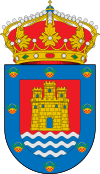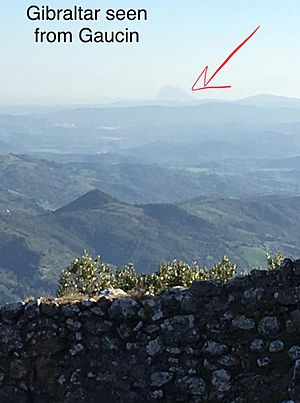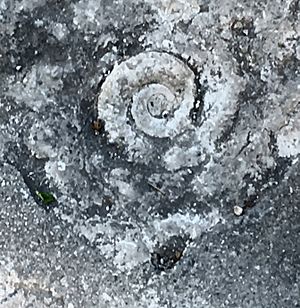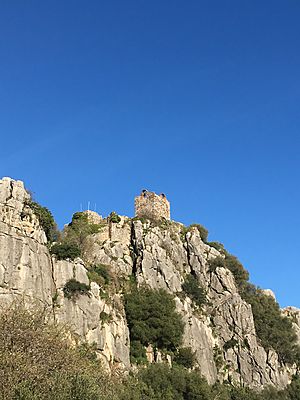Gaucín facts for kids
Quick facts for kids
Gaucín
|
|||
|---|---|---|---|
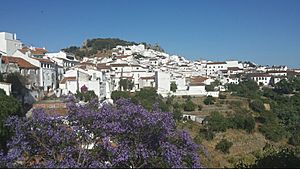 |
|||
|
|||
| Sovereign state | |||
| Autonomous community | |||
| Province | |||
| Area | |||
| • Total | 98 km2 (38 sq mi) | ||
| Population
(2018)
|
|||
| • Total | 1,573 | ||
| • Density | 16.05/km2 (41.57/sq mi) | ||
| Time zone | UTC+1 (CET) | ||
| • Summer (DST) | UTC+2 (CEST) | ||
Gaucín is a charming town in the mountains of Andalusia, a region in southern Spain. It's located in the province of Málaga, not far from the famous town of Ronda. About 2,000 people live in Gaucín. The town sits high up, about 600 meters (nearly 2,000 feet) above sea level. It's watched over by the impressive Castillo del Aguila, also known as Eagle's Castle. This castle started as a Roman fort and was later made bigger by the Arabs.
Contents
What Makes Gaucín Special?
Gaucín is famous for its amazing views! From here, you can see all the way to Gibraltar, across the Strait of Gibraltar, and even to Morocco in Africa. The mountains around Gaucín are also very beautiful.
Many visitors use Gaucín as a starting point to explore the "pueblos blancos" (white villages) of Andalusia. These are towns with white-painted houses that look stunning against the green hills. To reach Gaucín, you drive up a winding mountain road for about 24 kilometers (15 miles). The old medieval castle stands proudly above the village. More and more people from other countries are choosing to live here, adding to the town's friendly community.
Gaucín has inspired many artists and writers. It's sometimes called the "balcony of the Ronda Mountains" because of its wide views. You can see the Mediterranean Sea, including the famous Rock of Gibraltar, from many spots in the town.
You might even find fossils in the stone used to build some of the town's buildings and streets!
Fun Cultural Events
Gaucín has a lively cultural life with many traditions and festivals throughout the year.
Easter Celebrations
During Palm Sunday, there's a special procession to the church. On the night before Easter Sunday, a widely attended vigil takes place. On Easter Sunday itself, people celebrate with a traditional event called 'toro de cuerda'. A bull is released on a long rope in the morning, and then it is sold in the afternoon.
Carnival Fun
A big carnival celebration happens with groups called chirigotas. These are people dressed in costumes who sing funny songs about current events. There's also a big party in the main square with an orchestra that plays music until early morning!
Summer Festivals
In late July, the village holds a 'cultural week'. During this week, you can try local wine and meat. There are also live music performances in the main square.
The annual feria is a three-day festival celebrating the town itself. It usually takes place in early August. The feria has carnival rides and games. There's also a large tent where visitors can eat, drink, and watch musicians perform. A parade of horse riders competes for an award for the best-presented horse and rider.
Holy Child Pilgrimage
The pilgrimage of the Holy Child is a romeria (a religious journey) held on the last Sunday of August. A special image of the Holy Child is carried in a procession from the castle to a hermitage. This hermitage is believed to be where the Holy Child appeared. After a rociera (flamenco) mass, people enjoy dancing, singing, eating, and drinking until dawn.
Feast of the Holy Child
A feast honoring the Holy Child takes place on September 7th and 8th. For nine days before this, townspeople climb to the castle for a novena. This is a special prayer service held in the Chapel of the Holy Child. A Mass is celebrated, and guest preachers give sermons. A party is also held in the main square with processions, food, drinks, music, and dancing.
See also
 In Spanish: Gaucín para niños
In Spanish: Gaucín para niños



